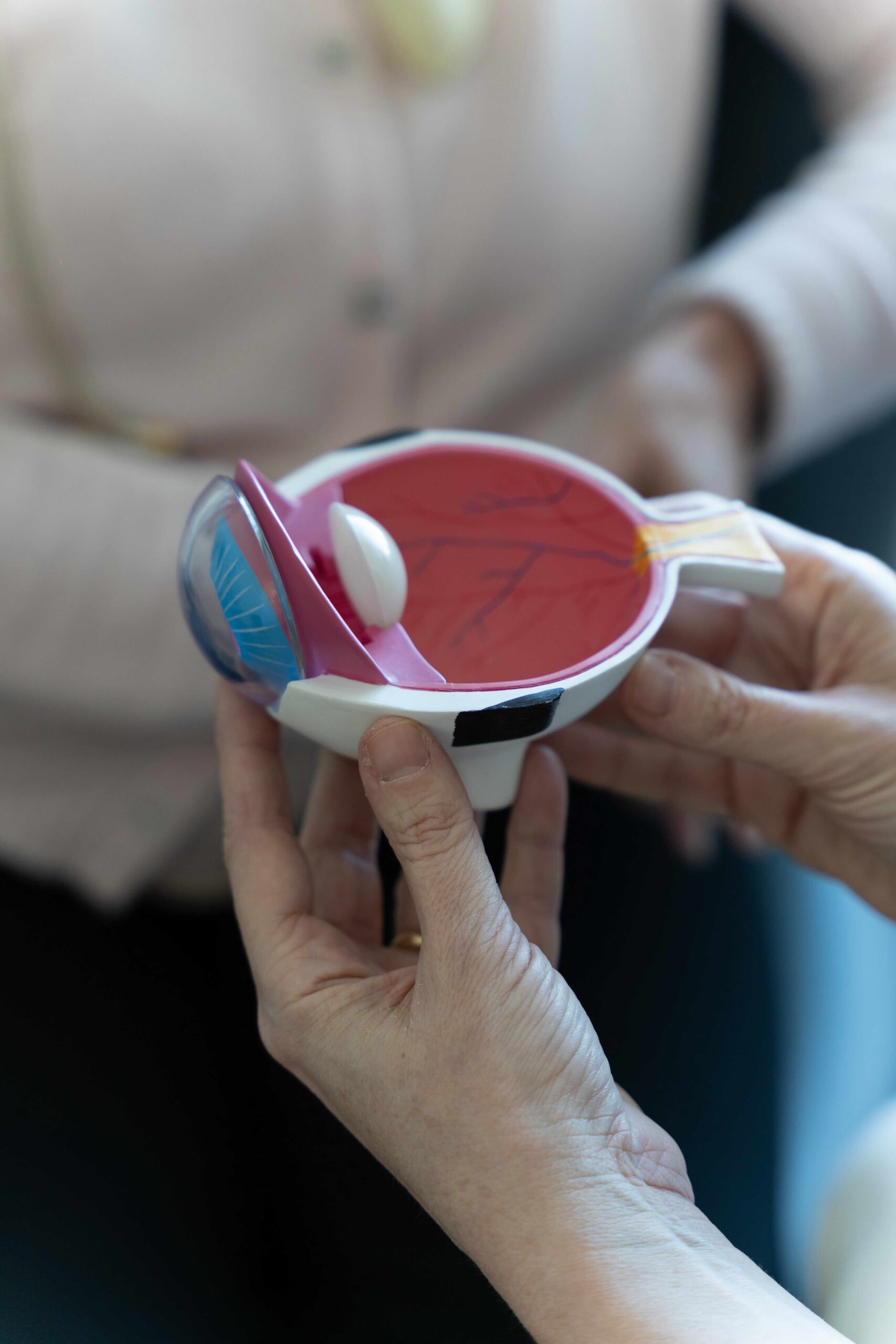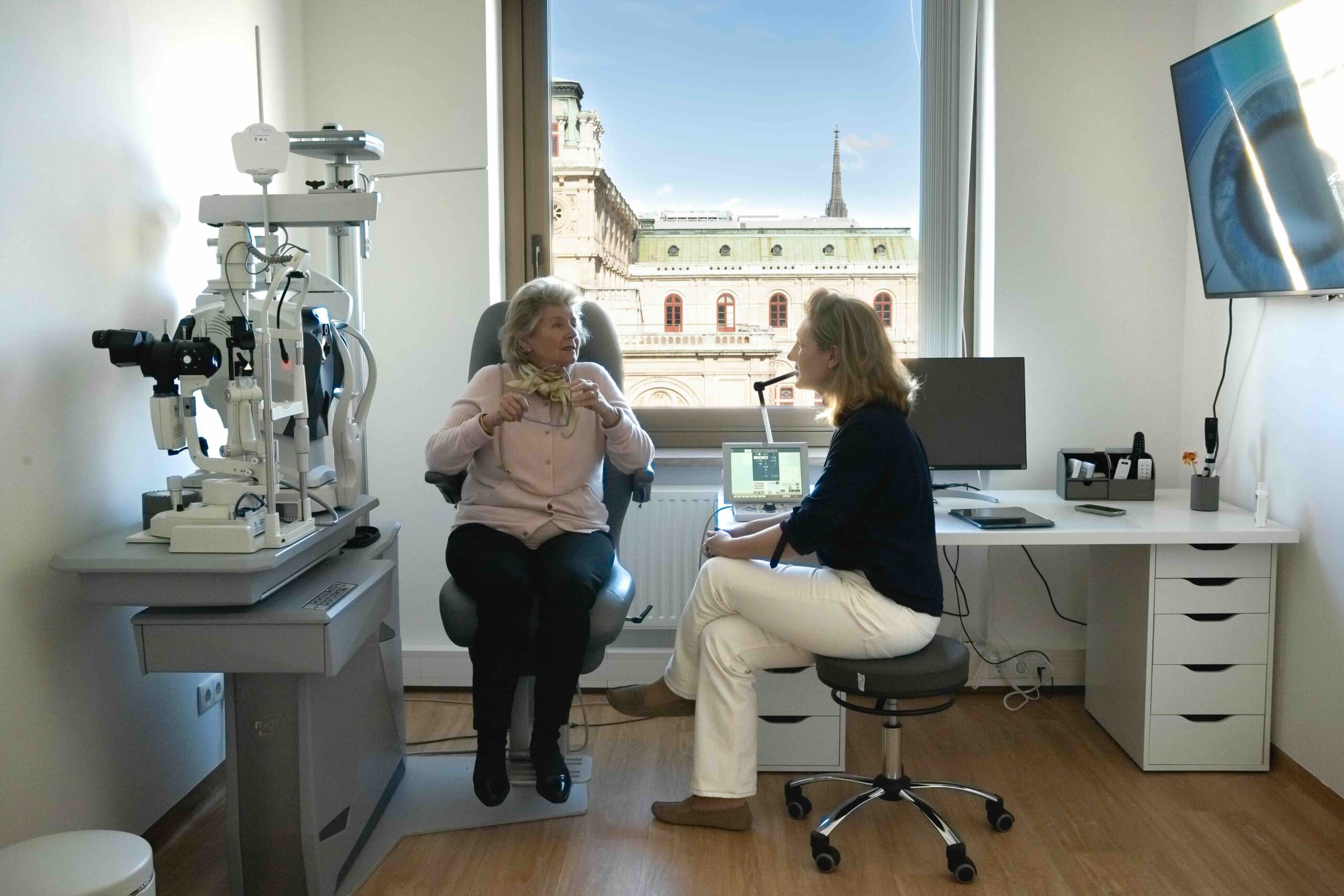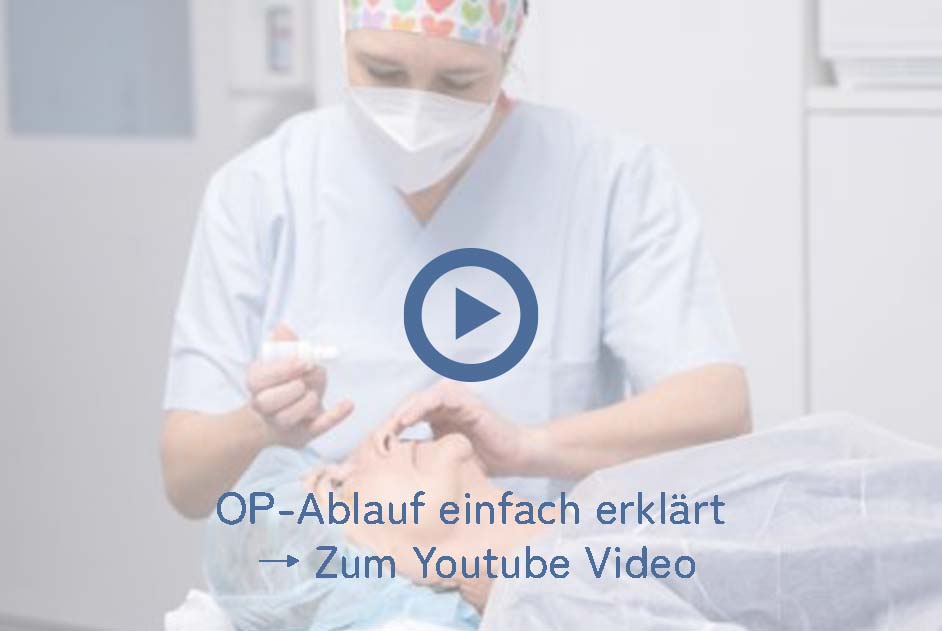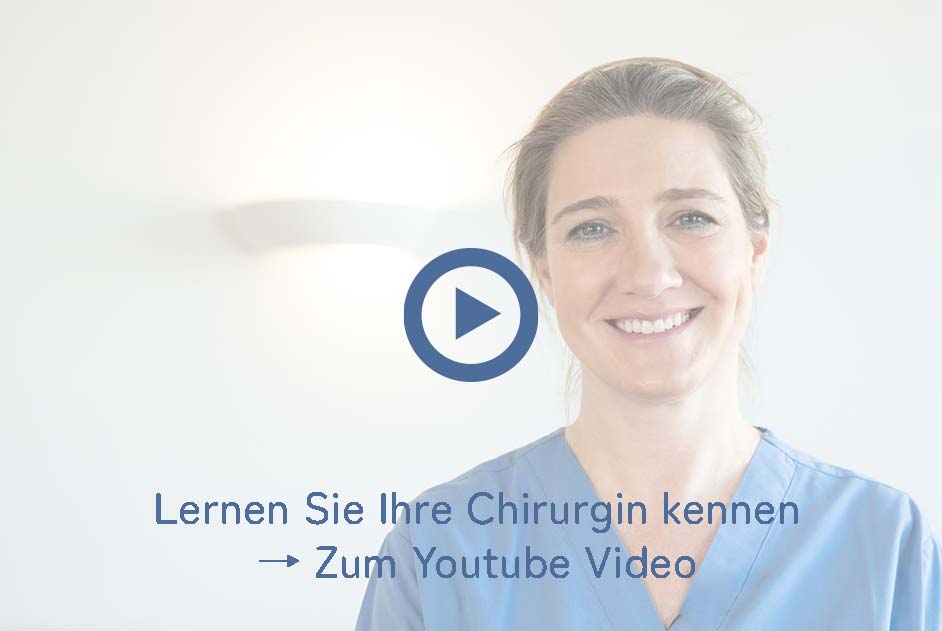Der Graue Star (Katarakt) bezeichnet eine Trübung der Augenlinse. Durch den natürlichen Alterungsprozess verklumpen die Eiweiße der natürlichen ursprünglich klaren Linse und führen so zu zunehmendem Verlust der Transparenz (Durchsichtigkeit) bis hin zu starker Linsentrübung. Dadurch kommt es zu langsamer Sehverschlechterung, verschwommenem Sehen, zunehmender Blendung oder auch veränderter Wahrnehmung von Farben und Kontrasten.
Im Laufe unseres Lebens bekommen die meisten von uns einen Grauen Star. Würde man alle über 65-jährige Personen untersuchen, fände man bei allen eine Linsentrübung. Das heißt aber noch nicht, dass deswegen eine Operation notwendig ist. Erst wenn zusätzlich zur Linsentrübung Sehstörungen hinzukommen, die die Patient*innen beeinträchtigen, dann kann eine Operation Abhilfe schaffen.
Die einzige Methode, den Grauen Star wirkungsvoll zu behandeln, ist die Graue-Star-Operation (Katarakt-Operation). Dabei wird die getrübte Linse durch eine künstliche Linse (Kunstlinse oder Intraokularlinse) ersetzt.


Mein Tätigkeits- und Forschungsschwerpunkt ist die innovative minimal-invasive Katarakt-Chirurgie. Besonders faszinieren mich dabei neue Implantate, wie Linsen zur Behandlung von Grauem Star und Alterssichtigkeit, beispielsweise Multifokal-, EDOF- oder Monofokal-Plus-Linsen, sowie fortschrittliche Operations-Technologien, wie der Einsatz des Femtosekunden-Lasers in der Kataraktchirurgie.
Mit 25 Jahren Forschung auf dem Gebiet der Kataraktchirurgie und mehr als 10.000 durchgeführten Operationen konnte ich umfangreiche Expertise in der Anwendung modernster Behandlungsmethoden und der Entwicklung neuer Technologien aufbauen. Meine jahrelange Erfahrung als Augenchirurgin und Wissenschaftlerin ermöglicht es mir, Ihnen nicht nur eine präzise Diagnose zu stellen, sondern Sie auch umfassend über die neuesten Entwicklungen und Alternativen in der Kataraktbehandlung zu beraten.
VOR DER OPERATION
Eine gründliche Untersuchung des gesamten Auges mit Erhebung der Augenvorgeschichte, des exakten Brillenstatus und Erweiterung der Pupille ist notwendig, um die Diagnose Grauer Star zu stellen und auch etwaige weitere Erkrankungen des Auges, wie beispielsweise ein Glaukom oder eine Netzhauterkrankung zu auszuschließen.
Die nahezu wichtigste Untersuchung vor der Operation ist die sogenannte Biometrie, die exakte Vermessung des Auges. Dazu zählt eine präzise Analyse der Hornhaut (Hornhaut-Topographie) und des vorderen Augenabschnitts mittels OCT (Optische Kohärenz Tomographie), sowie eine Messung der Augenlänge.
Mithilfe dieser Parameter wird mit modernen Formeln die Linsenstärke der Kunstlinse individuell berechnet. Anhand der vorliegenden Daten kann ich Sie ausführlich beraten, welcher Linsentyp für Sie infrage kommt, um nach der Operation optimal sehen zu können.

Besonders wichtig ist mir, im gemeinsamen Gespräch mehr über Ihre Lebensgewohnheiten und Hobbies, sowie Ihre Wünsche an Ihr Sehen herauszufinden. Ich nehme mir gerne die Zeit, Sie individuell zu betreuen und mit Ihnen gemeinsam eine maßgeschneiderte Lösung zu finden, die perfekt zu Ihrem Auge und Ihren Bedürfnissen passt. Dabei berücksichtige ich sowohl Ihre Wünsche als auch die modernsten medizinischen Erkenntnisse, um das bestmögliche Ergebnis für Ihr Sehen und Lebensqualität zu erzielen.
DER ABLAUF DER OPERATION
Am Tag der Operation kommen Sie bitte zum vereinbarten Zeitpunkt (etwa eine Stunde vor der Operation) in die Klinik. Sie können zu Hause eine leichte Mahlzeit einnehmen, sowie alle Ihre vorgeschriebenen Medikamente. Auf Wunsch können Sie ein leichtes Beruhigungsmittel erhalten. Das Auge wird für die Operation mittels pupillenerweiternden und betäubenden Augentropfen vorbereitet.
Im Operationssaal liegen Sie bequem auf dem Operationstisch, die umliegende Haut wird desinfiziert und nur das zu operierende Auge wird mit einem sterilen luftdurchlässigen Tuch abgedeckt. Mund und Nase bleiben frei und Sie können normal atmen.

An der Hornhaut wird ein kleiner 2.2 – 2.4 mm Schnitt durchgeführt, um Zugang zur Linse zu erhalten. Die vordere Linsenkapsel wird danach entfernt. Mittels eines hochfrequenten Ultraschall Handstücks (Phakoemulsifikation) wird die trübe Linse verflüssigt und abgesaugt. Das geschieht völlig schmerzfrei, Sie können lediglich einen leichten Druck oder Spülflüssigkeiten verspüren.
Nach Entfernen der Linse bleibt nur noch der Kapselsack bestehen. Dieser dient als Verankerung für die neue Kunstlinse. Diese wird mittels eines Injektors klein gefaltet ins Auge gebracht und entfaltet sich im Kapselsack.
Wenn die neue Linse gut im Auge sitzt werden die Flüssigkeiten, die während der Operation verwendet wurden abgesaugt und eine antibiotische Prophylaxe wird appliziert. Die Wunden verschließen sich durch die selbstdichtenden Schnitte von alleine. Das Auge erhält nach der Operation eine durchsichtige Schutzschale oder Schutzbrille.
NACH DER OPERATION
Nach der Operation können Sie, wenn Sie sich wohl fühlen, sofort nach Hause gehen. Das Sehen ist am Operationstag noch trüb – das ist ganz normal. Durch die weite Pupille und eine eventuelle Hornhautschwellung kann die Sicht verschwommen sein. In den folgenden Tagen wird Ihr Sehvermögen sich bis zur klaren Sicht verbessern. Manchmal kann der Heilungsprozess auch etwas länger dauern, das soll aber kein Grund zur Sorge sein – ich werde Sie gut in dieser Zeit betreuen und begleiten.
Sie dürfen nach der Operation keinesfalls Druck auf das Auge ausüben und nicht reiben, damit die kleinen Schnitte nicht aufgedrückt werden. Sie erhalten eine Schutzschale, die Sie in der ersten Woche in der Nacht über das Auge kleben sollen. Die entzündungshemmenden Augentropfen tropfen Sie bitte so ein, wie Sie es vorgeschrieben bekommen.
Ein leichtes Kratzen oder Fremdkörpergefühl nach der Operation ist normal, dagegen können Pflege (Befeuchtungs-)tropfen helfen. Bei starken Schmerzen oder Sehverschlechterung hingegen kontaktieren Sie bitte umgehend Ihre Klinik.
Die postoperativen Nachkontrollen erfolgen innerhalb der ersten Woche und nach einem Monat. Dabei wird der Heilungsverlauf und Sitz der Kunstlinse kontrolliert, auf etwaige Entzündungen geachtet und die Refraktion überprüft. Eine neue Brille, so eine erforderlich ist, kann frühestens nach 3-4 Wochen verschrieben werden. Oft gewöhnt sich das Gehirn erst langsam an den neuen Seheindruck, vor allem, wenn Sie Speziallinsen implantiert bekommen haben, oder Sie sehen anfangs in gewissen Situationen noch Schatten- oder Lichtphänomene. Dieser Gewöhnungseffekt – die sogenannte Neuroadaptation – kann einige Wochen bis Monate dauern.
Graue Star OP • Alles auf einen Blick
| OP Dauer: ca. 20 min | Betäubung: Augentropfen (Tropfanästhesie) | Kontrollen: innerhalb der 1. Woche und nach 1 Monat |
| Duschen: sofort | Schminken: nach 3 Wochen | Sauna: nach 3 Wochen |
| Fitness: sofort | Autofahren: nach der 1. Kontrolle | Sehen: am Tag der OP noch verschwommen, am nächsten Tag klar |
Häufig gestellte Fragen
Durch die langsame Trübung der natürlichen Augenlinse kommt es zu
- zunehmend verschwommener Sicht
- die Farben erscheinen blasser
- die Blendung nimmt zu (kann besonders beim Autofahren in der Nacht als störend empfunden werden)
- die Brille passt eventuell nicht mehr
Der richtige Zeitpunkt für die Kataraktoperation wird bei jedem Patienten individuell nach einer ausführlichen Untersuchung im persönlichen Gespräch mit Ihrer Augenärztin/Ihrem Augenarzt festgelegt. Ausschlaggebend ist, ob Sie durch den Grauen Star im täglichen Leben beeinträchtigt sind.
Das häufigste Verfahren der Kataraktoperation ist die sogenannte Phakoemulsifikation:
Zuerst wird das Auge mit Augentropfen örtlich betäubt. Durch einen kleinen Schnitt (Mikroinzision) wird das Auge eröffnet. Anschließend wird ein Teil der Linsenkapsel entfernt. Mittels hochfrequenter Ultraschall- Schwingungen (Phakoemulsifikation) wird die trübe Linse verflüssigt und absaugt. Zurück bleibt der klare leere Kapselsack, in den nun die neue Kunstlinse einsetzt werden kann.
Diese hochmoderne Operationstechnik hat den Vorteil, dass der Augapfel für die Operation nur sehr wenig geöffnet werden muss. Die kleinen Öffnungen verschließen sich von selbst und sind danach wasserdicht. Nur in Ausnahmefällen werden sie zusätzlich durch feinste Nähte gesichert.
Die Kunstlinse (Intraokularlinse) besteht aus Kunststoff wie Acrylate oder Silikone. Moderne Linsen werden für die Implantation gefaltet, sodass sie durch eine sehr kleine Öffnung ins Auge implantiert werden können. Der optisch wirksame Teil der Kunstlinse hat einen Durchmesser von sechs Millimetern. Stabile Bügel sorgen für einen sicheren Sitz in der Linsenkapsel. Der Körper verträgt diese Kunststofflinsen sehr gut – die Implantate können lebenslang im Auge bleiben.
Die Graue Star Operation wird in den allermeisten Fällen in Tropfanästhesie durchgeführt, das bedeutet, dass die Augenoberfläche mittels Augentropfen betäubt wird. Das ist ausreichend, da die Augenoberfläche, insbesondere die Hornhaut als einziges Gewebe Schmerznerven besitzt. Die Linse, die bei der Grauen Star Operation entfernt wird enthält keine Nerven. Sie können während der Operation etwas Druck oder Flüssigkeiten über das Auge rinnen spüren, aber Sie werden keine Schmerzen haben.
Wie bei jeder Operation kann es trotz aller Sorgfalt zu Komplikationen kommen, einige sind wie folgt beschrieben:
- Intraokularer Druckanstieg: Erhöhter Druck im Auge, der oft medikamentös behandelt werden kann.
- Hornhautödeme oder -schäden: Schwellungen oder Schäden an der Hornhaut können zu verschwommenem Sehen führen.
- Entzündungen: Leichte Entzündungen sind nach der Operation häufig und können normalerweise mit Augentropfen behandelt werden.
- Makulaödem (Zystoides Makulaödem): Eine Schwellung der Makula, die zu verschwommenem Sehen führt und mit entzündungshemmenden Augentropfen behandelt werden kann.
- Abweichen der Zielrefraktion: trotz sehr präziser Mess- und Linsenberechnungsmöglichkeiten kommt es in ungefähr von 2 von 10 Fällen vor, dass die angestrebte Refraktion (Brechkraft des Auges) um mehr als eine halbe Dioptrie abweicht. Je nach Abweichung kann eine Korrektur mit Brille oder Kontaktlinsen, ein refraktiver Hornhautlaser (touch-up) oder ein Linsenaustausch nötig werden
- Nachstar (sekundäre Katarakt): Eine Trübung der hinteren Linsenkapsel, die fallweise ein paar Jahre nach der Operation auftreten kann. Diese kann normalerweise mit einem kurzen, schmerzlosen Lasereingriff (YAG-Laser-Kapsulotomie) behoben werden.
- Dislokation der Intraokularlinse (IOL): Die Kunstlinse kann sich verschieben und möglicherweise eine weitere Operation erforderlich machen.
- Infektion des gesamten Auges (Endophthalmitis): Eine seltene, aber schwere Komplikation, die eine intensive Behandlung in einem Krankenhaus erfordert.
- Sehverlust: Extrem selten kann es zu einem dauerhaften Sehverlust kommen.
Die meisten Komplikationen sind gut behebbar, schwerwiegende Komplikationen sind zwar möglich, treten aber insgesamt selten auf. Der Großteil der Patienten erleben eine deutliche Verbesserung ihres Sehvermögens nach der Operation und erholen sich ohne größere Probleme. Es ist wichtig, alle prä- und postoperativen Anweisungen Ihres Augenarztes oder Ihrer Augenärztin zu befolgen, um das Risiko von Komplikationen zu minimieren.
Am Operationstag nehmen Sie bitte alle Ihre vorgeschriebenen Medikamente wie gewohnt ein. Auch blutgerinnungshemmende Medikamente (Thrombo ASS, Marcoumar, Plavix, Pradaxa, Xarelto, etc.) müssen vor der Operation nicht abgesetzt werden.
- Bitte nehmen Sie Ihre Mahlzeiten zu Hause wie gewohnt ein.
- Tragen Sie bitte kein Make-up auf und legen Sie keinen Schmuck an.
- Die Operation dauert insgesamt etwa 20-30 Minuten pro Auge.
- Das Auge wird gut betäubt, Sie können einen leichten Druck oder Flüssigkeiten spüren, werden aber keine Schmerzen haben.
- Ihr Auge wird mit einer kleinen Klammer offen gehalten, somit müssen Sie sich keine Sorgen machen, dass Sie zwinkern oder blinzeln.
- Wenn Sie einen Husten- oder Niesreiz verspürenmoder sich sonst unwohl fühlen, informieren Sie mich bitte umgehend.
- Während der Operation sehen Sie nur das helle Licht des OP Mikroskops. Versuchen Sie bitte diese Lichtpunkte möglichst ruhig während der Operation zu fixieren.
- Am Ende der Kataraktoperation bekommen Sie eine durchsichtige Schutzschale. Diese bleibt meist bis zum nächsten Tag über dem Auge und soll auch in der ersten Woche nach der Operation nachts getragen werden. Das ist wichtig, damit Sie nicht versehentlich am Auge reiben oder darauf liegen.
- Sie bekommen entzündungshemmende Augentropfen verordnet, die Sie bitte zuverlässig nehmen müssen.
- Fitness darf sofort betrieben werden. Sport bei dem die Möglichkeit einer Augenverletzung besteht sollte in den ersten zwei Wochen unterlassen werden.
- Vorsichtiges Waschen des Gesichts mit geschlossenen Augen und sauberem Wasser ist nach der Operation möglich. Achten Sie allerdings darauf, keinen Druck auf das Auge zu verüben, nicht am Auge zu reiben und vermeiden Sie direkten Augenkontakt mit verunreinigtem Wasser, Shampoo oder Seife.
- Autofahren ist erst nach einer postoperativen augenärztlichen Kontrolle mit Sehtest erlaubt.
- Wegen der Gefahr einer Infektion durch Keime in der Erde sollten Sie in den ersten zwei Wochen nach der Operation auf Gartenarbeit verzichten.
- Sauna und Schwimmbadbesuche sollten Sie in den ersten zwei Wochen nach der Operation wegen der Infektionsgefahr vermeiden.
Nach der Kataraktoperation wird Ihre Augenärztin/Ihr Augenarzt mit Ihnen Termine für Kontrolluntersuchungen vereinbaren, die Sie bitte auf jeden Fall einhalten sollen. Die Wahrscheinlichkeit, dass nach der Operation Komplikationen auftauchen, ist sehr gering. Sollten Sie dennoch:
– eine Verschlechterung bemerken
– Schmerzen haben
– das Auge stark gerötet sein oder
– Sie deutlich schlechter sehen
kontaktieren Sie unverzüglich Ihre Augenärztin/Ihren Augenarzt oder suchen Sie eine augenärztliche Notfallambulanz auf.
Eine Verbesserung des Sehens tritt meist in den ersten Tagen nach der Kataraktoperation ein. Die endgültige Sehschärfe kann auch erst in den darauffolgenden Wochen nach der OP erreicht werden.
Durch moderne Kunstlinsen ist es möglich Sehfehler, wie Kurzsichtigkeit, Weitsichtigkeit oder Hornhautverkrümmung gleichzeitig mit der Grauen Star Operation zu korrigieren. Es gibt auch Speziallinsen, die die Alterssichtigkeit (Presbyopie) korrigieren und ein nahezu brillenfreies Leben ermöglichen.
Die Auswahl der passenden Linse erfolgt auf Grund der Bauart Ihres Auges und Ihren persönlichen Anforderungen und Wünsche an Ihr Sehen. Ich berate Sie gerne und wähle gemeinsam mit Ihnen die für Sie individuell am besten geeignete Linse.
In manchen Fällen kann es nach Monaten oder Jahren wieder zu einer allmählichen Sehverschlechterung kommen – ein Nachstar (sekundäre Katarakt, posterior capsule opacification PCO) ist entstanden. Zellen, die bei der Operation im Kapselsack verblieben sind, können langsam wieder wachsen und die Kapsel trüben. Diese Trübung kann mittels kurzem schmerzlosem Eingriff ambulant mit einem Laser (Nd:YAG Kapsulotomie) endgültig beseitigt werden. Danach ist gutes Sehen wieder möglich.
Mit Standard Kunstlinsen (Monofokallinsen oder torischen Linsen) haben wir die Möglichkeit, bei der Grauen-Star-Operation gleichzeitig Kurz-, Weitsichtigkeit oder Hornhautverkrümmung (Astigmatismus) zu korrigieren. In den meisten Fällen benötigen Sie nach der Operation eine Brille, vor allem zum Lesen und für die Arbeit am Bildschirm. Moderne Speziallinsen hingegen können auch Alterssichtigkeit (Presbyopie) verbessern. So können wir den wachsenden Bedürfnissen und Ansprüchen unserer Patient*innen gerecht werden, ihre Sehkraft erheblich zu verbessern und die Abhängigkeit von Brillen zu verringern. Ein Leben ohne Brille oder mit weitgehender Brillenfreiheit bedeutet, ein hohes Maß an Lebensqualität zurückzugewinnen.
In einem ausführlichen Gespräch bespreche ich mit Ihnen Ihre individuellen Bedürfnisse, Anforderungen und Erwartungen an Ihr Sehen.
Standardmäßig wird eine Monofokallinse implantiert. Diese Linse hat einen Brennpunkt, das heißt, sie wirkt so, dass sie nur auf eine bestimmte Entfernung fokussiert. Das bedeutet, dass sie entweder für das Sehen in der Ferne oder für das Sehen in der Nähe optimiert ist, aber nicht für beides gleichzeitig. Für die jeweils andere Distanz ist weiterhin eine Brille nötig.
Alternativ dazu gibt es die Möglichkeit, eine Multifokallinse (Mehrstärkenlinse) zu implantieren. Diese Linsen verfügen über mehrere Zonen mit unterschiedlichen Brechungsstärken, die es dem Auge ermöglichen, auf verschiedene Entfernungen scharf zu sehen. Mit dieser Linse haben Sie die Chance, größtenteils auf Ihre Brille verzichten zu können – sowohl in der Ferne als auch in der Nähe, allerdings können als Nebenwirkung Blendung und Halos (Lichthöfe) auftreten.
Auch EDOF Linsen (extended-depth-of-focus Linsen; Linsen mit erweiterter Schärfentiefe) können das brillenlose Sehen in mehreren Distanzen, in diesem Fall Ferne und Zwischenbereich, ermöglichen. Diese Linsen haben oft weniger Nebenwirkungen, jedoch ist für das Lesen in der Nähe in den meisten Fälle eine Brille notwendig.
Monofokal Plus oder ‚Enhanced‘ (erweiterte) Monofokal-Linsen sind eine relativ neue Entwicklung auf dem Intraokularlinsen Sektor. Der Hauptfokus liegt wie bei Standard Monofokallinsen auf einer bestimmten Entfernung (meistens Ferne), aber durch die modifizierte Optik wird eine leicht verbesserte Tiefenschärfe erreicht, die sich in einer etwas verbesserten Zwischenentfernung bemerkbar macht.
Torische Linsen können eine vorbestehende Hornhautverkrümmung (Astigmatismus) korrigieren und sind heutzutage Standard, sowohl bei Monofokal- als auch bei Speziallinsen.
Hier finden Sie ausführliche Informationen über die verschiedenen Arten, sowie Vor- und Nachteile von Standard- und Speziallinsen
Die jüngste Innovation in der modernen Kataraktchirurgie ist der Femtosekundenlaser, der in der Laser-Grauer-Star-Operation (Femtosekundenlaser-assistierten Kataraktoperation, kurz FLACS) zum Einsatz kommt. Dieser Laser ermöglicht es, Gewebe computergesteuert und hoch präzise zu trennen, ohne dabei das umliegende Gewebe thermisch zu schädigen.
Die Femto-Kataraktoperation mit dieser neuesten Technologie besteht aus zwei Schritten: einem, der vom Laser durchgeführt wird, und einem, den der Chirurg manuell vornimmt. Der Femtosekundenlaser übernimmt dabei die Eröffnung der Linsenkapsel (Kapsulotomie), die Zerteilung der getrübten Linse (Linsenfragmentierung) sowie die Schnitte durch die Hornhaut. Auch bogenförmige Einschnitte zur Korrektur einer Hornhautverkrümmung (Astigmatismus) sind mit dem Laser möglich. Im Anschluss daran entfernt der Chirurg die vorfragmentierte Linse mit minimalem Einsatz von Ultraschallenergie und setzt die künstliche Linse ein.
Da ich als Privatärztin tätig bin, kann ich nur Patient*innen mit Zusatzversicherung oder Selbstzahler operieren. Graue Star Operationen werden von mir in der Privatklinik Confraternität oder in einem privaten OP durchgeführt.
Modelle für Zusatzversicherte:
| OP in einem Privatspital mit Implantation einer Standardlinse (monofokal oder torisch) | Direktverrechnung mit Ihrer Privatversicherung – keine zusätzlichen Kosten |
| OP in einem Privatspital mit Implantation einer Speziallinse (Monofokal Plus, EDOF oder Multifokallinse – auch torisch ) | Direktverrechnung mit Ihrer Privatversicherung für die OP – die Speziallinse muss selber gezahlt werden |
| OP im privaten OP mit Implantation einer Standardlinse (monofokal oder torisch) | Die OP muss vorerst selber bezahlt werden und kann danach bei Ihrer Privatversicherung eingereicht werden. Je nach Versicherung werden die Kosten fast zur Gänze übernommen |
| OP im privaten OP mit Implantation einer Speziallinse (Monofokal Plus, EDOF oder Multifokallinse – auch torisch ) | Die OP muss vorerst selber bezahlt werden und kann danach bei Ihrer Privatversicherung eingereicht werden. Je nach Versicherung werden die Kosten für die OP fast zur Gänze übernommen – die Speziallinse muss selber gezahlt werden |
Modelle für Selbstzahler:
| OP im privaten OP mit Implantation einer Standardlinse (monofokal oder torisch) | Die OP muss vorerst selber bezahlt werden und kann danach bei Ihrer gesetzlichen Krankenkassa eingereicht werden. Je nach Versicherung werden ein Teil der Kosten übernommen |
| OP im privaten OP mit Implantation einer Speziallinse (Monofokal Plus, EDOF oder Multifokallinse – auch torisch ) | Die OP muss vorerst selber bezahlt werden und kann danach bei Ihrer gesetzlichen Krankenkassa eingereicht werden. Je nach Versicherung werden ein Teil der Kosten übernommen – die Speziallinse muss selber gezahlt werden |
Eine Augenoperation können sich viele Menschen nicht wirklich gut vorstellen. Und verständlicherweise klingt alles, was für mich als Augenchirurgin selbstverständlich und tägliche Routine ist, sehr abstrakt und kann auch schon einmal unheimlich wirken. Einige meiner Patient*innen haben sich dankenswerterweise bereit erklärt über die Operation, Vorbereitung, Wahl der Linse und Nachsorge, über ihre Gefühle bei der Operation und Erlebnisse rund um die Graue Star Operation aus Patientensicht zu erzählen:
Viele Videos, in denen ich (fast) alles rund um die Graue Star Operation erkläre finden Sie auch hier:
https://www.youtube.com/@kataraktlaser



